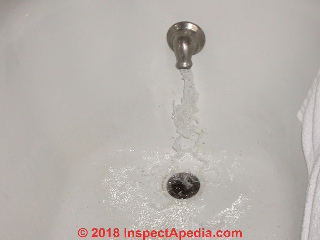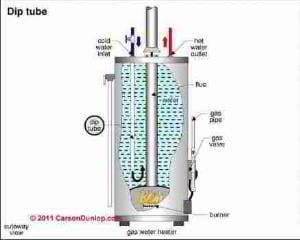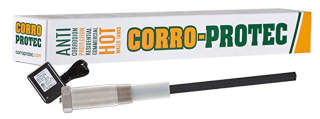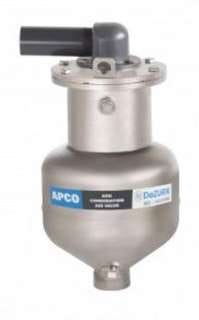 Air Discharge at Hot Water Faucets
Air Discharge at Hot Water Faucets
Diagnose & repair air bubbles, smells, odors at hot water only
- POST a QUESTION or COMMENT about air discharge at hot water outlets of plumbing fixtures
How to diagnose & fix air coming out of hot water faucets, tubs, showers, etc. :
This article describes the causes of air discharging from building hot water water supply piping or plumbing fixtures.
If air blasts out of your just your hot water faucets or fixtures we explain what's going on, why it's a problem, and how to diagnose and fix the trouble.
Some air discharge or bubbling issues in building piping are not serious, while others could spell expensive trouble. In this article series we list all of the various causes of air discharge at faucets or shower heads and how to correct each one.
InspectAPedia tolerates no conflicts of interest. We have no relationship with advertisers, products, or services discussed at this website.
- Daniel Friedman, Publisher/Editor/Author - See WHO ARE WE?
11 Causes of Air Discharge from Hot Water Faucets, Showers, etc.
 Watch out: if you find air discharging only from your hot water faucets a dangerous condition may be present: the hot water heating system may be too hot, risking scalding or even water heater explosion.
Watch out: if you find air discharging only from your hot water faucets a dangerous condition may be present: the hot water heating system may be too hot, risking scalding or even water heater explosion.
If your hot water is extremely-hot - scalding - then turn off power or fuel to the water heater itself and call a licensed plumber immediately.
Water heater sketch showing the water heater anode, courtesy of Carson Dunlop Associates, a Toronto home inspection, education, & report writing tool firm.
[Click to enlarge any image]
No water heater actually generates bubbles of true “air” (normal air is composed of 78 percent nitrogen and 21 percent oxygen) in the water piping system unless the heater is set at or above boiling (212°F or 100°C).
But depending on water chemistry, corrosive water reacting with the water heater sacrificial anode can generate hydrogen gas that might in more-extreme reactions appear as smelly and even combustible “bubbles” or “air” discharge at faucets.
The production of hydrogen in a water heater might occur with both magnesium anodes or aluminum anodes, though at least some plumbers suggest that changing from a magnesium to an aluminum anode may reduce the production of hydrogen.
Steps in the Diagnosis & Cure of Air or Smelly Gases at Hot Water Fixtures
If the “air” discharge you’re seeing is only in the hot water, the cause may indeed be hydrogen produced by the water reaction to the anode: a diagnostic clue would be odor. The hot water will smell bad, often sulfurous or like “rotten eggs”.
Solutions to Hydrogen “Air” discharge in hot water or hot water tank odors:
- Check the water heater temperature setting:
if the water heater temperature is set close to boiling you may be producing dangerously-hot scalding water.
See details
at WATER HEATER TEMPERATURE TOO COLD or TOO HOT
and at TABLE OF SCALDING TEMPERATURES & TIMES - Leaks anywhere in a water supply system
or, if your water supply is from a private well, well problems can produce air in the water supply system: occurring at both hot and cold fixtures (that it’s at both hot and cold is diagnostic).
If you see air discharge at both hot and cold plumbing fixtures then the water heater isn’t the source and you will want to see the diagnosis and cure found
at AIR DISCHARGE at FAUCETS, FIXTURES our home page for this topic where we list all of the causes of air discharge from plumbing systems. - Air trapped in water supply system:
Next, be sure the problem isn’t residual air in the water supply system or hot water tank left over from the building water supply having been shut-off and drained.
Be sure that the water tank has been re-filled completely by water, not air, if necessary draining air out of the water tank through the hot water outlet;
Some plumbers suggest opening the temperature/pressure relief valve, but there are a couple of warnings about that approach: - the relief valve, if old and not frequently inspected and tested, may refuse to close fully and may leak - requiring replacement (a good thing to do anyway in this case) and - the relief valve on many water heaters is high on the heater side, not at its top.
A side-mounted TPR valve won’t remove all of the air from the water heater. - Identify the "air" bubbles: is it hydrogen?
Does it smell like sulfur or rotten eggs? Can you light the bubbles? Is it only in the hot water supply?
Often if the problem is the reaction of corrosive water with the water heater anode and thus the gas produced is principally hydrogen, you might observe that the gas escaping at the hot water tap will actually burn, able to be ignited by a lighter or match.
This is both a diagnostic clue and perhaps an unpleasant or even in an unusual or extreme case, a dangerous condition.
Watch out: if the odors appear in both hot and cold water supply then the root problem isn't the hot water system. In that case see
GASES in WELL WATER
HYDROGEN SULFIDE GAS - sources of sulphur-like smells and the hazards of this gas, including explosion and sewer gas hazards.
SULPHUR & SEWER GAS SMELL SOURCES - list of sewer and sulphur gas odor sources
WATER ODORS, CAUSE CURE - Change the standard magnesium sacrificial anode
in the water heater (calorifier, geyser) for one made of aluminum. For some homes this change may be sufficient.
Above: Corro-Protec electrical anode for water heater protection, cited & discussed below.
- Install a special corrosion-protection anode
designed to reduce the hydrogen production, such as the Corro-Protect anode produced by that company ( web: https://www.corroprotec.com/ )
While a typical magnesium sacrificial anode protects the water tank itself from corrosion by sacrificing itself (it is formulated to react more-easily with the corrosive water than the steel water tank), a special electrically-powered-corrosion protection anode protects the water tank from corrosion using an electrical charge instead, avoiding the production of hydrogen. The anode controller monitors the electrical resistance (or conductivity) of the water and adjusts its electrical charge accordingly.
The Corro-Protec company describes how their product works as follows (quoting)
The Corro-Protec system includes a titanium anode and a current rectifier. When the rectifier is connected to the nearest outlet, the rod in the tank supply a small amount of current into the water heater. This current completely stops the loss of energy from all metals to which the ground is connected.
The corrosion process is then completely stopped. Since the anode is made out of titanium, it does not disintegrate over time. - Corro-Protec, 40 Boul. Industriel, Princeville, Quebec, Canada G6L2P4 - Have your water supply tested for corrosivity.
If your water supply is unusually corrosive you may need to install appropriate water treatment equipment to protect all of the plumbing system. In this case the “air” (hydrogen) bubbles in hot water are but a symptom of a larger problem.
Water tests for organics can also identify some odor sources in the water supply itself. But you'll see in the water odor diagnosis articles we cite herein that odors may be from a variety of source including sulfur, organics, bacterial contamination, etc. - Install an air eliminator: Some plumbers address hard-to-find air discharge problems by installing an air eliminator on the water piping.
Details are at AIR ELIMINATORS for POTABLE WATER SUPPLIES
You might use this to treat air dissolved in the water supply or air from some other sources but it's best to first understand why there is air in the water supply. - Check the municipal or well water supply for dissolved gases:
In some areas gases, including potentially dangerous explosive methane gas, may leak into the water supply and may be delivered into the building water piping from a well. Other gases often found in well water include radon, CO2 in some locations, and dissolved sulphur (that rotten egg smell).
Watch out: methane gas in well water is a pollutant and may be explosive.
Changes in water temperature also affect the amount of gases that remain dissolved in water - warming water drives gases out of solution.
- Check the building’s electrical ground system.
An experienced electrician can test your building’s electrical ground to be sure that it is properly installed. We have occasionally found a building whose main electrical ground was defective, leading to unanticipated electrical ground paths through unexpected pathways including electric water heater tanks and piping to a water main or through the coils of a groundwater source heat pump.
Unexpected electrical current flow through mechanical systems can show up as corrosion in a water heater tank or an HVAC cooling coil. - We emphasize that this is an unusual condition so it’s not usually the first thing we check.
Really? For clarity please note: the normal operation of the sacrificial anode in a hot water tank is an electrochemical process: electrolysis and has nothing to do with the building’s electrical system.
- Other types: very fine hot water air bubbles - milky hot water
The hot water air discharge problem we discuss here is a separate problem from the occurrence of extremely-fine air bubbles in hot water, often described as “milky” hot water that becomes clear if the water is run into a container and allowed to sit a few minutes.
Milky hot water is more likely due to the inability of the water to contain all of the air dissolved in the incoming cold water supply, and is harmless.
Air particularly wants to convert from dissolved gas to bubble form at water heaters, so often a plumber will install devices such as a microbubble resorber or an air vent right at the water heater to address this problem.
Microbubble resorbers and other air eliminators at the water heater are discussed
at AIR ELIMINATORS for POTABLE WATER SUPPLIES.
...
Reader Comments, Questions & Answers About The Article Above
Below you will find questions and answers previously posted on this page at its page bottom reader comment box.
Reader Q&A - also see RECOMMENDED ARTICLES & FAQs
2022/01/30 mod said: right idea, wrong anode.
RW please find a detailed answer to your question above on this page.
You'll see many causes of air in the hot water supply lines and at the hot water outlets, and just one solution involves changing the anode: from magnesium to aluminum.
Let us know what you find and do with this information as it will help other readers and may help us improve the article.
2022/01/30 RW said: new AOS water heater makes air in hot water lines: should I change from aluminum to magnesium anode rod?
New AO Smith electric hot water heater generates air in hot water lines. I’m on a well with water softener. I believe this unit has an aluminum anode rod. Should I change to magnesium?
2016/06/08 Mod said:
MIke, Please see AIR ELIMINATORS for POTABLE WATER SUPPLIES
2016/06/08 Mike P said:
We have very deep bedrock well - 385 ft deep. It produces 16 GPM. From the beginning the water has been full of small bubbles.
I am almost certain the bubbles are not mechanically produced as they occur when water is drawn directly from the well manifold before reaching any of the faucets and filtration systems.
There are so many bubbles when water is drawn from the manifold it is milky white, not just cloudy. It takes well over a minute for a 20 OZ glass of water to clear.
Question: air in the deep well system only shows up at one hot water faucet
(Mar 21, 2012) Jerry said:
I, too, have air in my deep well system but it only shows on ONE hot water faucet. 5-8 seconds of blowing air with little water.
Not noticable on the cold side or in the adjacent bathroom fixtures. Can a faulty hot-water faucet be the cause.? I've had the entire system examined and no one can find the problem. Rust filter tank, water softener and well pump all check out.
This Q&A were posted originally
at AIR ELIMINATORS for POTABLE WATER SUPPLIES
Reply:
This makes me think that the problem is in the hot water tank and piping and perhaps the closest hot water fixture.
See the article above on this page.
(Jan 23, 2013) John Smith said:
Mobile home on well, we have almost no cold water and hot water spits and sputters when running only at the kitchen sink any idea why it has been this way for months
...
Continue reading at AIR DISCHARGE at FAUCETS, FIXTURES - home, or select a topic from the closely-related articles below, or see the complete ARTICLE INDEX.
Or see these
Recommended Articles
- AIR DISCHARGE at FAUCETS, FIXTURES
- AIR OVERCHARGE in PRESSURE TANK
- AIR DISCHARGE from HOT WATER - you are on this page
- BURST BLADDER in WATER TANK
- CHECK VALVE FAILURES
- LEAKS in WELL PIPING
- LOSS of WATER in the WELL
- DAMAGED WELL PUMP
- AIR VOLUME CONTROL DEFECT
- GASES in WELL WATER
- SNIFTER VALVE MALFUNCTION
- WATER SOFTENER CHECK VALVE STUCK
- WATER TREATMENT EQUIPMENT
- OTHER SOURCES of AIR in WATER PIPES
- AIR ELIMINATORS for POTABLE WATER SUPPLIES
- ANODES & DIP TUBES on WATER HEATERS
- WATER HAMMER NOISE DIAGNOSE & CURE
- WATER ODORS, CAUSE CURE
Suggested citation for this web page
AIR DISCHARGE from HOT WATER at InspectApedia.com - online encyclopedia of building & environmental inspection, testing, diagnosis, repair, & problem prevention advice.
Or see this
INDEX to RELATED ARTICLES: ARTICLE INDEX to WATER SUPPLY, PUMPS TANKS WELLS
Or use the SEARCH BOX found below to Ask a Question or Search InspectApedia
Ask a Question or Search InspectApedia
Try the search box just below, or if you prefer, post a question or comment in the Comments box below and we will respond promptly.
Search the InspectApedia website
Note: appearance of your Comment below may be delayed: if your comment contains an image, photograph, web link, or text that looks to the software as if it might be a web link, your posting will appear after it has been approved by a moderator. Apologies for the delay.
Only one image can be added per comment but you can post as many comments, and therefore images, as you like.
You will not receive a notification when a response to your question has been posted.
Please bookmark this page to make it easy for you to check back for our response.
IF above you see "Comment Form is loading comments..." then COMMENT BOX - countable.ca / bawkbox.com IS NOT WORKING.
In any case you are welcome to send an email directly to us at InspectApedia.com at editor@inspectApedia.com
We'll reply to you directly. Please help us help you by noting, in your email, the URL of the InspectApedia page where you wanted to comment.
Citations & References
In addition to any citations in the article above, a full list is available on request.
- Air in Drinking Water, Environmental Fact Sheet, New Hampshire Department of Environmental Services, 29 Hazen Drive, Concord NH 03301 - web search 07/14/2010 original source: http://des.nh.gov/organization/commissioner/pip/factsheets
/dwgb/documents/dwgb-3-18.pdf
The purpose of this document is to identify possible explanations for fine white bubbles that are sometimes seen in drinking water immediately after the water is taken from a faucet. The condition is similar to effervescence. These bubbles disappear within approximately one minute after the water is drawn from the tap.
DES does not believe that there is a health significance to these air bubbles, however, they may create a safety risk as explained below. They may also indicate improper physical conditions in pumps, pipes, or other water system equipment. There are numerous possible explanations for these bubbles. - In addition to citations & references found in this article, see the research citations given at the end of the related articles found at our suggested
CONTINUE READING or RECOMMENDED ARTICLES.
- Carson, Dunlop & Associates Ltd., 120 Carlton Street Suite 407, Toronto ON M5A 4K2. Tel: (416) 964-9415 1-800-268-7070 Email: info@carsondunlop.com. Alan Carson is a past president of ASHI, the American Society of Home Inspectors.
Thanks to Alan Carson and Bob Dunlop, for permission for InspectAPedia to use text excerpts from The HOME REFERENCE BOOK - the Encyclopedia of Homes and to use illustrations from The ILLUSTRATED HOME .
Carson Dunlop Associates provides extensive home inspection education and report writing material. In gratitude we provide links to tsome Carson Dunlop Associates products and services.



